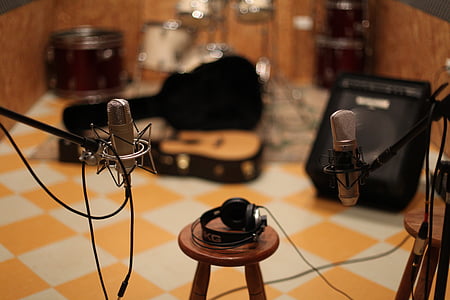Although there are full-service companies that you can hire to build an immaculate new control room for you, most of us have to make do with imperfect rooms and limited budgets. The following tips will help you turn a frustrating listening environment into a viable space for producing quality mixes.
1. Choose your listening position carefully:
“Listening position” refers to where your ears are. If space allows, your head should be centered between the left and right walls. This ensures that your left and right ears hear similar things.
Then, from front to back, the ideal listening position is the spot in the room where the frequency response is flattest, i.e. where the room least exaggerates certain parts of the audio spectrum. You can experiment to find this spot or you can use the “38% rule.” Industry wisdom says that frequency response is usually flat at 38% of the distance between the front and back walls. So in a 120” long studio, we want our listening position to be about 46” from the front wall.
2. Give your speakers some space:
The most common mistake I see in home studio setups is positioning the speakers too close to the wall behind them. Speakers should be at least a few feet away or bass frequencies will be exaggerated (and also sound “smeary”). If you’re skeptical, you can experiment with it yourself. If your room does not allow you enough space, then treating the reflection points behind the speakers (more on this in a moment) can help.
The speakers’ tweeters should be at the same height as your ears in listening position. The speakers should be about as far apart from each other as you are from each of them, forming an equilateral triangle with your head. Isolation pads under the speakers are great and can help you adjust height as well.
3. Acoustically treat your first-reflection points:
This is the first priority of acoustical treatment. Think of it this way: You hear the sound coming from your speaker directly to your ear, but when there is a solid surface off to the side, then you also hear the sound coming from the speaker, bouncing of the surface, then coming to your ear. You are therefore hearing the signal twice, slightly out of sync––and we haven’t considered the other walls (or floor or ceiling).
Imagine now that there is a mirror on the surface in question. If you can see either speaker in this imaginary mirror from your listening position, you are probably getting reflected sound off of that spot on the wall. Run this thought experiment with all walls, floors, and ceiling. Those spots should be acoustically treated to prevent reflections.
The same principles apply when recording––you want the microphone only to pick up the sound directly from the source, not the sound bouncing off the wall.
4. Minimize overall room ambience:
We’ve all walked into an empty room and heard how reverberant it is. While reverberation can be pleasant, it’s usually trouble in spaces that weren’t specifically designed to reverberate. A good rule of thumb is to say that 15-30% of the total surfaces in a room should be covered in something absorptive (rugs and furniture, while not always ideal, can be counted in the calculation). This should cut down on boominess and give you a more accurate sound.
5. Bass trap liberally:
Bass trapping is last in terms of treatment, not because it is least important, but because it is the most challenging and expensive. You need thick and/or dense material to absorb bass frequencies (I use 6 lb/sq ft. fiberglass panels >4” thick) and it’s rare that a room is over-bass trapped: within reason, the more bass treatment, the better. You can build bass traps on your own, or they can be found used. Corners are the standard placement position for bass traps because it maximizes air space behind the panels (which extends effective frequency range) without taking up too much usable space.
6. Select high-quality materials:
My main pet peeve in self-treated studios is overuse of acoustical foam. Although it can be helpful, foam is not very dense and therefore is only capable of absorbing relatively high frequencies. If you extensively treat a room with foam, when you clap your hands, you will not hear an echo. Room fixed, right? Wrong. The foam hardly affects mid and low frequencies, meaning that you’ve just dampened the highs in your room without handling anything else. More than likely, the room is now boomy and unnatural-sounding. It may be worse than before.
Fiberglass insulation (the denser the better) or compressed cotton can both be sourced for a reasonable price and won’t have to be abandoned when you upgrade. There are lots of online guides to making panels and traps with these materials.
You can find special acoustically transparent fabric to cover it with, but on a budget a good rule of thumb is that if you can easily breathe through the fabric, then it will let through sound and not be too reflective.
7. Don’t let the perfect be the enemy of the good:
There is no such thing as an acoustically perfect environment. If you can only afford a little bit of acoustical treatment, then start with your first reflection points and upgrade little by little as you can afford more material. If you buy good-quality material and treat it kindly, it can move with you from studio to studio for the rest of your life; this can be treated as an ongoing project that you’re always tweaking. There are great resources online and in books to help fill out the knowledge that this article doesn’t have room to cover. Perfecting your working environment is a lifelong project and I encourage your experimentation and creativity.













